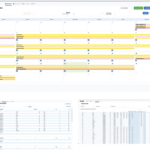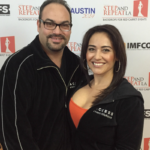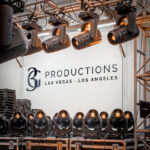It’s hard to remember a time when video wasn’t part of the live event landscape, though Danny O’Bryen sure does. He was there. As a kid, O’Bryen’s first gig in the business was plastering Boston with concert posters for $50 a day. This led to some live event work and then, wisely, he dabbled in video in the earliest part of the visual revolution..
In 1989, he got a call from production manager George Travis asking if he could put a video system together for Madonna’s tour. He rented the gear, and sent it out. Next came an AC/DC tour, then Metallica’s “Wherever We May Roam” tour in 1993. “That was it,” O’Bryen says. “I knew I had to stop everything else and just do video.”
With Tom McCracken, O’Bryen established BCC Video, which evolved into Screenworks, then Screenworks/NEP. The company has garnered many accolades, including four Parnelli Awards as Video Company of the Year. The company is also a three-time recipient of Pollstar’s Video Company of the Year award.
The company is well known for providing the big screen treatment for Aerosmith, Madonna, Kenny Chesney, Fleetwood Mac, Billy Joel and AC/DC, among others. But the concert and festival business only accounts for about 40 percent of the company’s total business. Corporate and sporting events also play important roles in Screenworks/NEP’s overall business.
O’Bryen cut his teeth in the video business under some pretty big names, including LD Marc Brickman. He was there when Brickman designed the breakthrough Genesis tour of 1992, We Can’t Dance, which included use of a Sony Jumbotron. “To this day, that was one of the best shows I’ve ever seen,” O’Bryen says. The groundbreaking tour involved three big screens at a cost of $5 million. O’Bryen would buy part of that system and send it out on with Metallica, and then Guns N’ Roses. “We airfreighted it from England to Toronto, and it caught fire with Metallica who was coheadlining with Guns & Roses. Then at that same show, [lead singer] Axl Rose caused a riot postponing the tour, and I thought, ‘Oh great, it’s all over.’” But the young company recovered, and he went on to do Rolling Stones’ Voodoo Lounge tour in 1994-1995, another major step forward in live event video work that clearly established his talents.
These experiences were critical in inspiring O’Bryen to always pursue better, more road-worthy video equipment used in more creative ways. He saw the future of concert touring, and that future would increasingly depend on video.
NEP
The “NEP” of Screenworks/NEP gets left off sometimes in this industry, but O’Bryen is quick to point out the advantage that resulted from the 2002 merger of the two companies. NEP is the largest supporter of event broadcasting in the world, and their 140 production trucks handle not only most of the award shows, but 70 percent of what happens in the premium sports facilities. Their remote facilities are all over the country and Australian and Europe too. Screenworks is deeply embedded into NASCAR events, and recently Daytona boasted two 40-by-80-foot video screens, plus two more 28-by-45 screens. They are also out 52 weeks a year with World Wrestling Entertainment (WWE).
Explaining the relationship to NEP, O’Bryen states that they are broadcasters and he and his team are the rock ‘n’ roll guys. “They pretty much let me run things the way I want to, and yet offer great support and resources, including capitalization,” he explains. “They have a good support system. I used their trucks recently doing George Straight at AT&T Stadium that had 105,000 people there, the largest indoor concert in North America.” NEP is the largest buyer of Sony cameras in the world, so they get a good price break that they are able to pass on to their clients, another clear advantage. Screenworks/NEP has vast resources to create new products, which is another advantage to Screenworks. Just recently they released the new X7-HD LED display, a custom-designed and purpose-built video display.
“We’ve been through it all — all the bands, the technology, the curveballs. We were the only ones that built the frames and could package these screens safely and effectively. Others would copy it, but they didn’t get it right. Also, too many others don’t understand how important the quality of the screen is. There’s a lot of cheap crap out there, and if you do an A/B comparison, you can see it. Also, a lot of that stuff won’t last a year. So for us, it’s all about inventory that looks great and is reliable.”
Meanwhile on the West Coast, Screenworks has a total of 70,000 square feet of warehouse space in Camarillo and Corona, California. And they recently hung a shingle out in Music City.
Nashville
“This new facility will significantly speed up delivery to events in the region, reduce transportation costs, and reduce our carbon footprint as well,” says O’Bryen. “Having a facility in this region will also allow our clients in the area to easily look at the range of HD LED display configurations, projectors, HD camera systems, and flypack solutions that we can provide.” Screenworks has a foundation of three major country acts that anchors them here — Tim McGraw, Kenny Chesney, and Eric Church. They’ve also just added Miranda Lambert as a client. The new warehouse will actually go far to help them with a lot of their NASCAR work, which tends to have events in the southeastern part of the country. They are also involved with other fun projects, like the SFX featvial “Tomorrowland.”. “It wasn’t just country music that brought us here.”
“We’ve been talking about opening a Nashville Office for four years,” says Randy Mayer, director of touring of Screenworks. Mayer adds that this move meets the growth spurt of the company in general — they needed more warehouse space, so naturally Nashville was the place to do that. But they are increasingly doing a lot of festival work, particularly EDM. “We have a great set of people who know how to do festivals to the point that we come in and take care of everything , and it’s one headache the promoters don’t have to worry about.”
While the new address still has that new warehouse smell, Mayer is already looking beyond it. “I predict that we’ll outgrow this space in two years, and in five years this office will be bigger than our Southern California one,” he says. “We’re really making a major effort here, and jumping in with both feet.” Headed by Andy Gerber, they plan to build up the team now that they have access to so much local talent and good production people.
O’Bryen adds: “This isn’t just about gear. It all comes down to people, and we’ve been lucky to have really good crews. That’s the difference — that and our years of experience packaging it. At the end of the day it’s who is the best and who supports your system that matters most. When Fall Out Boy rolled a truck, we were there, replacing the screen onsite by 8 a.m. the next day. We had an instance of N’SYNC getting caught in the rain and our guys went into the shop and worked late into the night, providing another massive LED screen screen shipping it out so they had one for their next show. Everyone who works for me has been around the block, and we’re cued up. We’re used to fire drills, and we still live by the creed that you’re only as good as your last show.”
For more information, please visit http://nepinc.com/welcome/screenworks.


